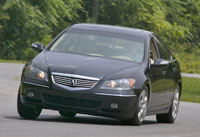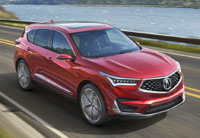
Acura rolled a few eyes when introducing its somewhat wordy Super Handling All-Wheel Drive back in 2004, but as soon as the automotive press drove the brand’s then-new 2005 RL flagship luxury sedan all snickering stopped, it really was super.
A decade and a half later the Japanese luxury brand is now celebrating a significant milestone, the 15th anniversary of its industry-leading torque-vectoring SH-AWD technology. To mark the event, Acura has produced a video (see below) highlighting the advanced all-wheel drive system’s history and capability.
SH-AWD actively and continually distributes engine torque between the front and rear wheels, from 70 percent to the front and 30 percent to the rear, or 30 percent to the front and 70 percent to the rear, while additionally up to 100 percent of rear twist could be distributed to either the left or right wheel to reduce understeer and therefore aid high-speed cornering. Of course, SH-AWD has improved with each new generation, and now is either standard or available in five of Acura’s six models.

The latest version of Acura’s mechanical SH-AWD, now in its fourth generation, debuted on the new 2019 RDX last year, with 40 percent greater torque capacity at the rear axle, quicker front-to-rear torque transfer, plus 30 percent faster torque transfer between the left and right rear wheels.
Looking toward the future, the 2014 RLX Sport Hybrid, the second-generation 2017 NSX, and the 2017 MDX Sport Hybrid came equipped with the most advanced iteration of SH-AWD yet. The new Sport Hybrid SH-AWD system incorporates electric motor torque for a more immediate application of four-wheel performance as well as much greater efficiency.
The mid-engine NSX supercar utilizes a unique design with three electric motors, two of which form a Twin Motor Unit (TMU) that distributes torque to each front wheel individually, whereas the RLX and MDX reverse the process with the gas-electric hybrid engine up front and TMU in back, distributing torque between each rear wheel, just like with the mechanical SH-AWD system. Despite the different layouts, the supercar, sport sedan and three-row SUV that feature Acura’s electrified Sport Hybrid SH-AWD system apply identical technologies and use many of the same components.

Also notable, later this year Acura will be celebrating another milestone, one million SH-AWD-equipped vehicles sold worldwide. Past models equipped with SH-AWD have included the RL (2005-2012) that utilized the first-generation system, the MDX (2007-2015), RDX (2007-2012), TL (2009-2014), and ZDX (2010-2013) that incorporated the second-generation system with Hill Logic, VSA and TCS, the TLX (2015-present) and MDX (2016-present) that feature the third-generation system with a 25-percent lighter rear differential and more, RDX (2019-present) that boasts the fourth-generation system with a more compact and quicker responding design, and lastly the RLX Sport Hybrid (2015-present), NSX (2017-present) and MDX Sport Hybrid (2017-present) that feature the electrified Sport Hybrid SH-AWD system.
Make sure to check out our photo gallery above to see images of all the aforementioned Acura models past and present, plus remember to watch the “What is Acura Super Handling All-Wheel Drive?” video below that details out the history and capability of Acura’s SH-AWD system:
What is Acura Super Handling All-Wheel Drive? (6:23):
